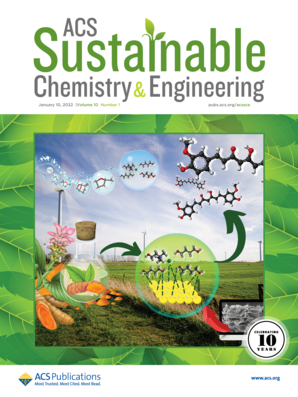NiCo Alloy Encapsulated in Sulfur and Nitrogen Codoped Carbon Nanofiber as Efficient Oxygen Reduction Electrocatalysts for Direct Methanol Fuel Cells
IF 7.1
1区 化学
Q1 CHEMISTRY, MULTIDISCIPLINARY
引用次数: 0
Abstract
The design and development of highly active and stable oxygen reduction reaction (ORR) catalysts are urgently necessary for the efficient operation of direct methanol fuel cells (DMFCs). In this research, a straightforward electrostatic spinning technique was integrated with a pyrolysis process to synthesize NiCo alloy nanoparticles embedded in sulfur (S) and nitrogen (N) codoped one-dimensional (1D) carbon nanofibers. The peak power density of the DMFC modified with NiCo2-A@S-NCNFs reached 29.70 mW cm–2, which is nearly comparable to that of the Pt/C-based DMFC (29.57 mW cm–2). The augmented ORR activity of NiCo2-A@S-NCNFs can be attributed to the advantages brought about by the S, N codoped carbon nanofibers and the synergistic interaction with the NiCo alloy. This combination not only supplies a larger quantity of active sites but also facilitates rapid electron and mass transport. Furthermore, the NiCo2-A@S-NCNFs catalysts demonstrated remarkable durability. The 1D nanofiber interconnect network effectively immobilizes NiCo alloy nanoparticles to prevent agglomeration, forming a stable conductive structure and an efficient electron transport pathway, thereby enhancing the durability of NiCo2-A@S-NCNFs. This study offers an effective approach for the design of heteroatomically doped carbon materials to enhance the ORR performance of non-noble-metal catalysts in fuel cells.

硫氮共掺杂纳米碳纤维包封镍合金作为直接甲醇燃料电池高效氧还原电催化剂
设计和开发高活性、稳定的氧还原反应催化剂是直接甲醇燃料电池(dmfc)高效运行的迫切需要。在本研究中,将简单的静电纺丝技术与热解工艺相结合,合成了嵌入硫(S)和氮(N)共掺杂一维(1D)碳纳米纤维中的NiCo合金纳米颗粒。NiCo2-A@S-NCNFs改性后的DMFC的峰值功率密度达到29.70 mW cm-2,与Pt/ c基DMFC的峰值功率密度(29.57 mW cm-2)接近。NiCo2-A@S-NCNFs的ORR活性增强可归因于S, N共掺杂碳纳米纤维带来的优势以及与NiCo合金的协同作用。这种结合不仅提供了大量的活性位点,而且促进了电子和质量的快速传递。此外,NiCo2-A@S-NCNFs催化剂表现出显著的耐久性。一维纳米纤维互连网络有效地固定了NiCo合金纳米颗粒防止团聚,形成了稳定的导电结构和高效的电子传递途径,从而增强了NiCo2-A@S-NCNFs的耐久性。本研究为设计杂原子掺杂碳材料以提高燃料电池中非贵金属催化剂的ORR性能提供了有效途径。
本文章由计算机程序翻译,如有差异,请以英文原文为准。
求助全文
约1分钟内获得全文
求助全文
来源期刊

ACS Sustainable Chemistry & Engineering
CHEMISTRY, MULTIDISCIPLINARY-ENGINEERING, CHEMICAL
CiteScore
13.80
自引率
4.80%
发文量
1470
审稿时长
1.7 months
期刊介绍:
ACS Sustainable Chemistry & Engineering is a prestigious weekly peer-reviewed scientific journal published by the American Chemical Society. Dedicated to advancing the principles of green chemistry and green engineering, it covers a wide array of research topics including green chemistry, green engineering, biomass, alternative energy, and life cycle assessment.
The journal welcomes submissions in various formats, including Letters, Articles, Features, and Perspectives (Reviews), that address the challenges of sustainability in the chemical enterprise and contribute to the advancement of sustainable practices. Join us in shaping the future of sustainable chemistry and engineering.
 求助内容:
求助内容: 应助结果提醒方式:
应助结果提醒方式:


